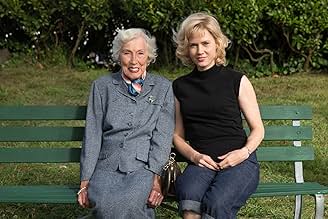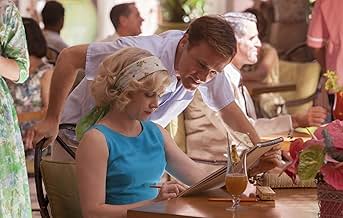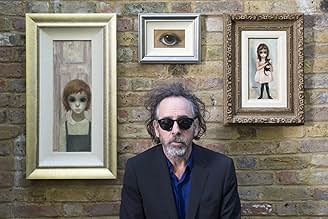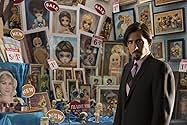Un dramma sul risveglio della pittrice Margaret Keane, il suo fenomenale successo negli anni '50 e le successive difficoltà legali che ha avuto con suo marito, che ha rivendicato il merito d... Leggi tuttoUn dramma sul risveglio della pittrice Margaret Keane, il suo fenomenale successo negli anni '50 e le successive difficoltà legali che ha avuto con suo marito, che ha rivendicato il merito delle sue opere negli anni '60.Un dramma sul risveglio della pittrice Margaret Keane, il suo fenomenale successo negli anni '50 e le successive difficoltà legali che ha avuto con suo marito, che ha rivendicato il merito delle sue opere negli anni '60.
- Regia
- Sceneggiatura
- Star
- Nominato ai 2 BAFTA Award
- 3 vittorie e 18 candidature totali
- 2nd Olivetti Girl
- (as Emily Bruhn)
Recensioni in evidenza
A premise that has lots of potential is partially wasted in aimless scenes or in repetitiveness. The film doesn't really make a point about anything and has way too much flashy stuff to feel grounded in any way. There would be nothing wrong there, but the fact that in it's uneven tone there seems to emerge a will to give an accurate and worthy recounting of these events makes so much of the drama feel out of nowhere. Storytelling isn't exactly where the movie succeeds. The courtroom scenes are definitely the weakest of all and made me mad multiple times because of their absolute preposterousness.
Anyways, the film is built around a strong enough cast, photography, premise, writing and design that it would be hard to get bored in anyway. The pace is fluent enough and the duration of the film is just about right for the content it presents. I wanted to like this more and see the story be given a better portrayal, but in no way I could say "Big Eyes" was a failure.
And then there's the main problem: Christoph Waltz. He's not the only one at fault - his character goes from charming to cartoon villain which can certainly be blamed on the writers and Burton - but his over acted performance, particularly towards the end, completely obscured any depth that Walter's character may have had.
Amy Adams, on the other hand, is fantastic and certainly the movie's saving grace. I would have liked to see more of her relationship with Walter, more of what made her willing to keep cranking out paintings for her husband, though I suspect a more three-dimensional Walter would have been needed for that.
And the narrator/reporter was completely unnecessary. I kept forgetting he existed and then wondering who was talking for a few seconds before I remembered that the movie had a narrator.
All in all, entertaining but disappointing. 6/10
"Big Eyes" (2014) is more of good feel comedy drama then a serious biography drama as it's genre indicates. Yes, it is based on a very true story, but this is not a typical biopic by any means. It's a "light" and easy movie, with some great performances by both leads, tight pacing, very nice writing and directing. No wonder that it was mentioned in an Comedy or Musical categories at Golden Globes and not in motion picture drama.
Overall, this is true very well made biography drama about some painters and frauds. Won't going to spoil anything, just going to say that i was very surprised by the ending when i find out that this actually happen, well, probably not word by word but the outcome did happen actually how it was portrait in the movie. This is a very fine picture from legendary director Tim Burton, and safe to say that this is his best movie in years simply by not being "a Tim Burton's" movie as we know them. This small budget picture (in terms of other's T.Burton's flicks) actually is much more lovely and intimate then his recent works. I will go even so far and say that i haven't enjoy his movie so much since 1999's "Sleepy Hollow".
This film is a biopic of 1950s novelty pop artist Margaret Keane (formerly Ulbrich, nee Hawkins). She developed a series of haunting acrylic paintings of kids with big dark round eyes. Walter Keane, her rascal salesman of a husband, took advantage of the rising popularity of her paintings. He claimed and mass-marketed them as his own.
Meanwhile, timid Margaret was forced to conform to his web of lies. She was locked in her workroom in their home to paint even more Big Eyes, away from the prying eyes of the public, and even her own daughter. Will Margaret be able to break free from the prison she has trapped herself into?
Amy Adams quietly carried this film capably on her shoulders. There was nothing funny about what she had to do here as Margaret. Her character was the victim of a most cruel crime. Her husband stole not only her art, but also her confidence, and her very freedom. Adams played a weak character, but as an actress, Adams was anything but. With her wise underplaying, Adams successfully won our empathy and compassion for her difficult plight.
Christoph Waltz, on the other hand, was over-the-top, one-dimensional, practically cartoonish, as the manipulative con-man Walter. From his very first scene, you already knew this smooth-talking guy was up to no good. Up to his very last scene in that courtroom, Waltz's Walter was a manic caricature, never really coming across as a real person at all. This may well Tim Burton's direction in play, as this character Walter was the source of most of this film's black humor. Waltz's fiery interaction with Terence Stamp's harsh NY Times art critic character is most memorable as well.
This film's narrative was simple and straightforward. Yet because of Amy Adams' riveting and heart-rending performance, we will be held until the compelling end. The technical aspects of the film, particularly the pastel color palette of the photography, as well as the period production design, costumes and makeup, all contribute to the overall charming look and nostalgic feel of the film as a whole. 7/10.
Margaret (Amy Adams) is trying to scrape together a living for herself and her young daughter when she meets Walter Keane (Christoph Waltz), a charismatic real-estate broker who would rather make a name for himself as an artist. He offers her a home, love and financial security, and she quite happily takes his surname as her own. Once they are married, Walter keeps trying to break into the notoriously snobby art world, selling his own Parisian landscapes and Margaret's portraits of wistful young girls with enormous eyes. But it's her art - simply signed as 'Keane' - that grabs the attention and, as one white lie leads to another, Margaret suddenly finds herself shoved into the background. Walter has taken credit for her work, and is well on his way to transforming it into a global phenomenon.
There are many big ideas swirling around in Big Eyes: art, deceit, integrity, commercialism and love are shaken liberally and stirred through with deeper issues of sexism and psychological abuse. This comes through pretty well in the film, which paints a chilling picture of Margaret's enforced anonymity. As her husband delights in dominating newpaper headlines and picking fights with famed art critics like John Canaday (Terence Stamp), she fades almost literally into the background - creating ever more pieces of art for him in the solitude of her attic studio, lying even to her daughter about her life's work. The film also draws a canny, subtle distinction between the artist and the businessman: Walter may not be much of the former, but his skills as the latter are what drag Margaret's work from county fairs onto the international stage.
Through it all, Burton exercises a light - almost impersonal - touch. He scatters a few scenes into the film that hint at his trademark film-making style: Margaret bumps into a crass supermarket display of her art, and suddenly everyone around her sports the limpid, haunting eyes of the waifs no one knows are hers. But, for the most part, Burton keeps himself out of the proceedings. It's proof that he can create nightmares on a more subtle and realistic level, capturing the darker side of life as it can be rather than as he imagines it. Occasionally, however, the film begs the question whether he should - it's stuffy and dry, never quite engaging either the heart or the imagination.
That's through no fault of his cast. Adams anchors Big Eyes with an astounding portrayal of a complex woman: one who's willing to cast off the chains of her first marriage, only to wind up tangled in the snare of another. It would be easy to play Margaret as a victim, but Adams finds the bitter strength in someone who must endure untold torment in a world and home that constantly remind her she's too weak to succeed on her own. Waltz's performance, on the other hand, is puzzling - he plays Walter in the constant key of manic, right from the start, so that the character's smooth, smug charm is all you ever see of the man. There is something undeniably delicious, though, about Waltz's Walter when the cracks begin to show: he simmers his way into a kind of monstrous madness, which lends both drama and humour to the proceedings when Margaret finally brings her claim to court.
On the evidence of Big Eyes, there's hope yet for Burton if he would like to switch to making more literal films. He unearths plenty of smart, insightful tension in this troubled marriage, a partnership on unequal terms that becomes less emotional and more financial by the day. But the film also stumbles along at points, bled dry when it should radiate colour and emotion. It's hard to shake the feeling, too, that Waltz seems to be under the impression that he's in a more old-school, over-the-top Burton production. It's at these moments, in particular, that one might long for a splash of Burton's own personality - the chance to look at this world, this story and these people through his eyes.
Lo sapevi?
- QuizMargaret Keane: Reading a book on a park bench behind Margaret and Walter, when they paint in front of the San Francisco Palace of Fine Arts. The end-credit photo of her sitting with Amy Adams was taken when this scene was filmed.
- Blooper"Tomorrow Forever," the UNICEF painting Margaret Keane painted for the 1964 Worlds Fair, was never actually mounted in the Hall of Education. Robert Moses, who had control over everything that was included in the fair, hated it. Once New York Times critic John Canaday trashed it after seeing a photograph of it, Moses had it thrown into the garbage.
- Citazioni
Ruben: What's that with the big crazy eyes?
Walter Keane: Oh. Well, I believe that you can see things in the eyes. The eyes are the window to the soul.
I più visti
- How long is Big Eyes?Powered by Alexa
Dettagli
- Data di uscita
- Paesi di origine
- Siti ufficiali
- Lingue
- Celebre anche come
- Ojos grandes
- Luoghi delle riprese
- Aziende produttrici
- Vedi altri crediti dell’azienda su IMDbPro
Botteghino
- Budget
- 10.000.000 USD (previsto)
- Lordo Stati Uniti e Canada
- 14.482.031 USD
- Fine settimana di apertura Stati Uniti e Canada
- 3.001.738 USD
- 28 dic 2014
- Lordo in tutto il mondo
- 29.261.617 USD
- Tempo di esecuzione1 ora 46 minuti
- Colore
- Mix di suoni
- Proporzioni
- 1.85 : 1
Contribuisci a questa pagina












































